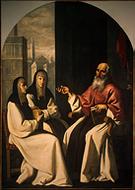
|
Francisco de Zurbarán and Workshop Francisco de Zurbarán (painter) Spanish, 1598 - 1664 Francisco de Zurbarán and Workshop Francisco de Zurbarán (related artist) Spanish, 1598 - 1664 Saint Jerome with Saint Paula and Saint Eustochium, c. 1640/1650 oil on fabric Overall: 245.7 x 173.5 cm (96 3/4 x 68 5/16 in.) framed: 264.2 x 192.4 x 9.5 cm (104 x 75 3/4 x 3 3/4 in.) Samuel H. Kress Collection 1952.5.88 |
Object 4 of 7
In seventeenth-century Spain, the religious orders were unrivaled in their patronage of the arts. Among the most important were the Hieronymites, whose white and brown habits are worn by these three saints: Paula, her daughter Eustochium, and Sophronius Eusebius Hieronymous, called Jerome in English. Under Jerome's spiritual direction, the two women founded a hospice and convent in the Holy Land that were regarded as the initial establishments of the Hieronymite Order. Paula and Jerome hold books, alluding to Jerome's role as the translator of the Bible into Latin. Paula, a well-educated woman from an illustrious Roman family, assisted Jerome with translations from Greek. Although Jerome is traditionally shown in a cardinal's garb, this is ahistorical. He died around 420, but the office of cardinal was not created until the end of the eleventh century, and the red robe and hat were not adopted until the mid-1200s.
This work relies on a formula Zurbarán used for a series of pictures he painted in the late 1630s for the Hieronymite monastery of Guadalupe. There is extensive reworking in the contours of the figures -- probably an indication that while Zurbarán established the composition, the actual painting was carried out by assistants. Paula's robe, for example, appears doughy and lacks volume as it falls to the floor. Her stony expression and awkward thumb also suggest the hand of an assistant.
| « | back to gallery | » | continue tour |


